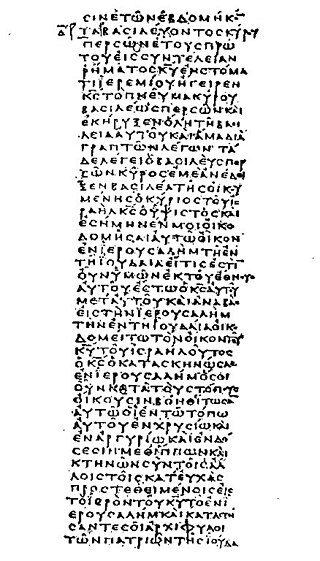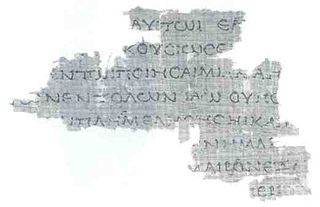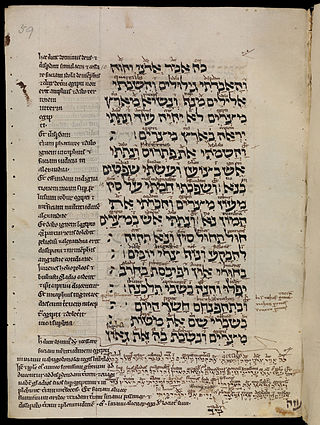Related Research Articles

The Septuagint, sometimes referred to as the Greek Old Testament or The Translation of the Seventy, and often abbreviated as LXX, is the earliest extant Greek translation of the Hebrew Bible from the original Hebrew. The full Greek title derives from the story recorded in the Letter of Aristeas to Philocrates that "the laws of the Jews" were translated into the Greek language at the request of Ptolemy II Philadelphus by seventy-two Hebrew translators—six from each of the Twelve Tribes of Israel.
Antonio Maria Ceriani was an Italian prelate, Syriacist, and scholar.

The Codices Ambrosiani A–E are five biblical manuscripts dating to the 6th–11th centuries CE now in the Biblioteca Ambrosiana in Milan. They are written by different hands and in different alphabets. The codices contain scattered passages from the Old Testament (Nehemiah) and the New Testament, as well as some commentaries known as Skeireins, rare survivals in the Gothic language.

Papyrus 110, designated by 𝔓110 is a copy of the New Testament in Greek. It is a papyrus manuscripts of the Gospel of Matthew, containing verses 10:13-15 & 10:25-27 in a fragmentary condition. Using the study of comparative writings styles (palaeography), the manuscript has been dated by the INTF to the early 4th century CE. Papyrologist Philip Comfort dates the manuscript to Middle-Late 3rd century CE. The manuscript is currently housed in the Papyrology Rooms of the Bodleian Art, Archaeology and Ancient World Library at Oxford University, with the shelf number P. Oxy. 4494.
The Syro-Hexaplar version is the Syrian Aramaic (Syriac) translation of the Greek of the Septuagint as found in the fifth column of Origen's Hexapla. The translation was made by Bishop Paul of Tella at the monastery of the Enaton in Egypt around 617.

Codex Marchalianus, designated by siglum Q, is a 6th-century Greek manuscript copy of the Greek version of the Hebrew Bible known as the Septuagint. It is now in the Vatican Library. The text was written on vellum in uncial letters. Palaeographically it has been assigned to the 6th century. Marginal annotations were later added to the copy of the Scripture text, the early ones being of importance for a study of the history of the Septuagint.

Allen Paul Wikgren was an American New Testament scholar and professor at the University of Chicago. His work centered on the text of the New Testament and New Testament manuscripts, but also included Hellenistic and biblical Greek, the deuterocanonical books (apocrypha), early Jewish literature, and work on the Revised Standard Version English translation of the Bible.

Papyrus Rylands 458 is a manuscript of the Pentateuch in the Greek Septuagint version of the Hebrew Bible. It is a roll made from papyrus, which has survived in a very fragmentary condition. It is designated by the number 957 on the list of Septuagint manuscripts according to the numbering system devised by biblical scholar Alfred Rahlfs. Using the study of comparative writing styles (palaeography), the manuscript has been dated to the middle of the 2nd century BCE.

Papyrus 967 is a 3rd-century CE biblical manuscript, discovered in 1931. It is notable for containing fragments of the original Septuagint text of the Book of Daniel, which was completely superseded by a revised text by the end of the 4th century and elsewhere survives only in Syriac translation and in Codex Chisianus 88. The manuscript is also important for early variants, both in the text of the Book of Ezekiel and of the Book of Daniel.

The manuscript 4Q120 is a Septuagint manuscript (LXX) of the biblical Book of Leviticus written on papyrus, found at Qumran. The Rahlfs-No. is 802. Paleographically it dates from the first century BCE. Currently the manuscript is housed in the Rockefeller Museum in Jerusalem.

The AqBurkitt are fragments of a palimpsest containing a portion of the Books of Kings from Aquila's translation of the Hebrew bible from the 6th century, overwritten by some liturgical poems of Yanai dating from the 9–11th century. This Aquila translation was performed approximately in the early or mid-second century C.E. The manuscript is variously dated to the 6th-century CE, or 5th-6th century CE.

The siglum AqTaylor are fragments of a palimpsest containing a portion of the Palestinian Talmud in upper script, and part of the Book of Psalms of Aquila's Greek translation of the Hebrew Bible in lower script. This latter is a Greek biblical manuscript written in codex form. This manuscript has been dated after the middle of the fifth century C.E., but not later than the beginning of the sixth century C.E.

Ezekiel 10 is the tenth chapter of the Book of Ezekiel in the Hebrew Bible or the Old Testament of the Christian Bible. This book contains the prophecies attributed to the prophet/priest Ezekiel, and is one of the Books of the Prophets. In this chapter, Ezekiel sees "God's Glory depart from the Temple".
P. Lond.Lit.207 is a Greek fragment of a Septuagint manuscript written on papyrus in codex form. This manuscript discovered at Fayum, contains parts of the Book of Psalms. Palaeographycally it is dated to late third century or early fourth century.
Papyrus Oxyrhynchus 4443 is a fragment of a Septuagint manuscript (LXX) written on papyrus in scroll form. It is the oldest extant manuscript that contains Esther 8:16–9:3 of the Septuagint text and verse numbering, according to the text of LXX. The manuscript has been assigned palaeographically to 50–150 CE.
Taylor-Schechter 16.320 is a Greek biblical manuscript written on parchment in codex form. This is a palimpsest that contains the Palestinian Talmud and the Septuagint Psalms. The manuscript is dated 550 – 649 CE.
The Papyrus Schøyen MS 2648 are six leaves of a papyrus codex of the Septuagint that contain the text of Joshua 9:27-11:3 in Koine Greek. It has been dated to the early third century.
The Papyrus Deissmann is a septuagint manuscript written in papyrus that contains parts of the Book of Exodus. Using the study of comparative writing styles (palaeography), it has been dated to 3rd-century. Currently is kept at Armidale, Private collection, Australia.

The Papyrus Chester Beatty VI are fragments of a papyrus manuscript of the Greek Septuagint and one of the Chester Beatty papyri. It contains parts of the Book of Numbers and Deuteronomy. Using the study of comparative writing styles (palaeography), it has been dated to 200 CE.
The Papyrus Leipzig Inv. 170 is a fragment of a septuagint manuscript written on papyrus in codex form that contains part of the Psalms. Palaeographically it has been dated to the 3rd century CE.
References
- ↑ Rey, Jean-Sébastien; Joosten, Jan, eds. (2011). The Texts and Versions of the Book of Ben Sira: Transmission and Interpretation. Supplements to the Journal for the Study of Judaism. BRILL. p. 158. doi:10.1163/9789004207189. ISBN 9789004207189.
- 1 2 Dorival, Gilles (2021). The Septuagint from Alexandria to Constantinople: Canon, New Testament, Church Fathers, Catena. Oxford University Press. p. 99. ISBN 9780192898098.
- 1 2 Otero, Andrés Piquer; Torijano Morales, Pablo A., eds. (2016). The Text of the Hebrew Bible and Its Editions: Studies in Celebration of the Fifth Centennial of the Complutensian Polyglot. Supplements to the Textual History of the Bible. BRILL. p. 272. doi:10.1163/9789004335028. ISBN 9789004335028.
- ↑ Vergarli, Emidio (2013-02-06). "An Introduction To Ceriani's Reprint Of The Ambrosian Manuscript B 21 Inf. (Codex Ambrosianus 7A1)". In Ceriani, Antonio Maria (ed.). A Facsimile Edition of the Peshitto Old Testament Based on Codex Ambrosianus (7a1). Gorgias Press. pp. vii–xv. doi:10.31826/9781463229924-001. ISBN 9781463229924.
- ↑ Bitton-Ashkelony, Brouria; Krueger, Derek, eds. (2016). Prayer and Worship in Eastern Christianities, 5th to 11th Centuries. Taylor & Francis. p. 45. ISBN 9781317076421.
- ↑ Shaw, Frank E. (2014). The Earliest Non-mystical Jewish Use of Iαω. Leuven: Peeters. p. 40. ISBN 9789042929784. OCLC 911062854.
- ↑ Ceriani, Antonio Maria. Codex Syro-Hexaparis Ambrosianus potholithographice editus. Monumenta Sacra et Profana. Vol. 7. Milan: Pogliani.
- ↑ Jellicoe, Sidney (1993). The Septuagint and Modern Study. Eisenbrauns. p. 127. ISBN 9780931464003.
- ↑ Toca, Madalina; Batovici, Dan, eds. (2020-01-13). Caught in Translation: Studies on Versions of Late-Antique Christian Literature. Texts and Studies in Eastern Christianity. BRILL. doi:10.1163/9789004417182. ISBN 9789004417182. S2CID 241127499.